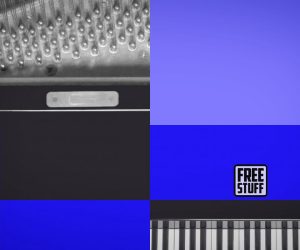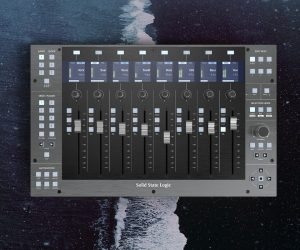
Sound for Sunset Boulevard
Sound design at the pointy end of musical theatre is precise. Like, at least two decimal points ‘precise’.
System Sound has been at the pointy end of musical theatre sound design for decades. I spoke to David Greasley and David Letch just prior to Sunset Boulevard’s run in Australia – a totally new production and a new audio design to match.
Before I got into the specifics (spoiler alert: lots of Meyer Sound loudspeakers, including some new Lina, along with a totally maxed out Digico SD7, plenty of DPA mics and dozens of channels of Sennheiser Digital 6000 Series wireless) I asked the Davids about the underlying philosophy to the design (spoiler alert: lots of speakers!).
David Greasley kicks us off: “Musical theatre producers want the seemingly impossible: they want the show to sound as natural as possible – with the music sounding like it’s coming from the orchestra pit and the vocals sounding like its coming from the singer on stage – but they also want the sound to be present and exciting – big, luscious and involving.”
David Letch continues: “To achieve this we start with solid fundamentals – non negotiables. Everyone in the house hears audio from more than one source. Every loudspeaker (with rare exceptions) carries the same FOH mix.”
OH NATURAL
Let’s start by covering off the ‘natural sounding’ requirement first. With its sound designs, System Sound has perfected the ideal musical theatre ‘goldilocks’ balance where audiences for most of a show don’t feel the need to ‘lean forward’ or ‘lean back’ in their seats. Performances emanate effortless from the point on the stage where they’re situated. The orchestra sounds like a natural extension of its presence in the orchestra pit. And this is true for every seat in the house – from the first row to the gods.
When you think about that for a minute, it dawns on you: how the heck do they do that? How does someone in the back corner enjoy the same audio imaging as another person in the front row? (Spoiler alert: lots of speakers… and lots of matrix outputs.)
IN THE ZONE
David Greasley: “We are very specific in how we zone the speaker system. There are multiple zones in the hall and multiple zones on the stage. When we go to optimise the system we place a source, a loudspeaker, on one of the stage zones, then we measure that source with a microphone in each zone of the hall. The measurements result in a timing delay for each of the loudspeaker sources. We rinse and repeat that process around 90 times – multiple zones on stage measured in multiple zones in the hall. Some seats will be directly hearing three, four, or five loudspeaker sources, while others, say, right under the balcony, will only be hearing two sources. Regardless, the time alignment will be precise – there’s no messy, image-blurring multiple arrivals coming at you at different times. This is why we’re not afraid of multiple sources, not when each loudspeaker or array has its own output from a Meyer Sound Galaxy and its own precise delay setting. In fact, multiple (time aligned) sources help with the imaging (they can pull the image down to the stage, for example) and help the audience feel more involved.”

This GUI shows the delay settings for one of the Meyer Sound Galaxy processors – eight inputs and 16 outputs. Each number represents the delay setting in milliseconds for eight of the on-stage zones translated to each loudspeaker location. This ensures solid localisation of the performers on stage along with perfect time alignment of the speakers to every zone in the theatre.

BIG & LUSCIOUS
Which leads us to how Messrs Greasley and Letch meet the demand for a ‘big, luscious sound’. Yes, lots and lots of loudspeakers.
David Letch: “One example are the two Meyer Sound M1D elements we have placed on their sides pointing to cover the seats on the edge of the stalls. They have a very tight HF pattern control (the M1D was one of Meyer Sound’s original line array components), their sound just races up the side and only impacts a small number of seats. Those seats are also in the coverage pattern of the Meyer Sound Lina array, and also in the coverage of downfill from a Meyer Sound UPJunior in the truss above the proscenium… and the UPJunior side-fill mounted to the wall. That’s a lot of sources but their all time aligned such that the audience member can no longer point to a speaker source, only to an apparent source on stage.”
David Greasley: “Those sidefills are deceptive. It’s very hard to tell if they’re switched on or not. They’re reproducing the same FOH mix as the other speakers and because they’re timed back to the Lina line arrays they’re perfectly in sync. We can tweak the delay setting somewhat to make them more noticeable, but that not the point. They contribute to the big, impressive sound we’re after. Turn them off and you definitely hear it. You have a smaller sound. Turn off all those additional fill speakers and you’re left with a ‘small PA’ sound.”
Side note: the side fills are also used as effects speakers, along with many other EAW JF80s placed around the perimeter, but the effects from QLab are on a different VCA.
MILLIMETRE PERFECT
Having the audience area granularly zoned such that theatre-goers enjoy a mix composed of a number of different loudspeaker sources precisely timed to provide natural imaging and coherence, has other benefits, David Greasley suspects: “I think we get a bit more gain before feedback. There’s no, one, large wavefront that’s exciting the room and getting back to the stage. I think it allows us to sneak in a few more dB here and there, which is especially important on shows like Sunset Boulevard, where the production requirement is for totally hidden microphones.”
Some shows, especially higher energy shows, are happy to concede the existence of headset microphones in exchange for more level. Other shows strictly adhere to the more traditional approach of hiding tiny microphones in the hairline of the performers.
Sunset Boulevard leans on the DPA 4061 and Sennheiser MKE1 miniature mics for the performers. The 4061 is the mainstay of musical theatre while the MKE1 is more of the upstart.
“The 4061 is just such a natural, transparent-sounding microphone,” confirms David Letch. “And the reason why it’s a musical theatre staple.”
“But the Sennheiser MKE1 is so tiny that it’s proving to be a good option as well,” continues David Greasley. “Being so small it gives you a bit more flexibility in the placement.”
Sally Hitchcock is the show’s radio technician. Hers is a crucial job of placing the capsule on the performer, mostly just up into the hairline above the middle of the forehead.
“Sally is very experienced and does an amazing job,” according to David Greasley. “The level of precision is pretty extreme. You can quite easily hear it if the mic has moved… even a millimetre.”
Performers’ mics are plugged into a Sennheiser SK6212 pack which is tiny, allowing for plenty of options as to where to stash it… including in the wig.
Sennheiser’s Digital 6000 Series wireless handles the rest, proving to be an extremely reliable and solid performer.


This triangle deserves a A$3000 DPA 4011. Change my mind.

The pit is bristling with DPA 4011 and Genelec 8030 monitors.
FOLDBACK PRAGMATICS
With a bunch of omni miniature microphones all open on stage, foldback is a tricky exercise. Increasingly, musical theatre is relying on a larger number of smaller speakers concealed in cavities under the stage. The Sunset Boulevard stage wasn’t deep enough to allow it, so monitoring needed to be placed elsewhere – pointing down from above and from the side of stage, in the ‘ladders’ side of stage, in the scenery/staging… pretty much anywhere the Messrs Greasley and Letch could hide a loudspeaker.
“Performers spend months rehearsing with piano accompaniment without microphones or loudspeakers,” explains David Letch. “It not like a rock band where they might be in a rehearsal space with everything turned up to 11. So our principals aren’t expecting ‘more me’ in the foldback, even if we could give it to them. Mostly they’re after enough orchestra to feel confident in their ability to pitch correctly.”
Interestingly, the principals are also given a touch of vocal reverb in the foldback. It simulates any vocalists’ ideal of singing in the natural acoustic of an amazing theatre. It also gives the performer something to ‘push into’ as they up their dynamics in a big chorus, for example. It’s subtle but something many performers notice and appreciate.

Hang space at the Princess Theatre is limited. Meyer Sound’s very compact Lina to the rescue.

Foldback is sometimes cleverly concealed in the scenery. It’s all about getting loudspeakers as close to performers without getting in the road.
NIGHT AFTER NIGHT
Sound design for musical theatre is very niche. System Sound’s expertise extends well beyond the Australian shores. David Greasley, especially, find himself jetting about the region ensuring the vision of show creators and producers is realised.
“We’re quite fortunate in Australia,” notes David Greasley. “Broadway and West End sound designers will often make the trip to Australia for an extended period and System Sound benefits by those direct collaborations. Then we’re naturally trusted to take that vision and ensure it’s realised elsewhere in the region.”
The ‘bedrock’ approach of pushing, effectively, the same mix into every loudspeaker in the theatre is one of those philosophies imparted from revered international sound designers. But it isn’t a universally held approach.
“We’re big proponents of the ‘one mix’ philosophy,” confirms David Greasley. “Knowing that when you push up the master fader 1dB on the mixer, that you’re uniformly pushing the mix everywhere, is reassuring. Or, if you’re adjusting the balance of orchestra and vocal by 0.5dB that everyone in the theatre hears that adjustment, I think is important. Otherwise, I think you can get into trouble and chase your tail if things aren’t entirely going to plan.”
And in the end for Messrs Greasley and Letch, that’s the goal – no surprises. The role is about meticulous preparation and reproducibility to ensure amazing results night after night and city after city.
Main System
22 x Meyer Sound Lina
8 x Meyer Sound Leopard
2 x Meyer Sound UPQ-1P (Downfill)
12 x Meyer Sound MM4-XP (Front Fill)
3 x Meyer Sound ULTRA- X40 (Mid Delay)
Pit Imaging
4 x Meyer Sound M1D
Side Fill
6 x Meyer Sound UPJunior
2 x Meyer Sound M1D
Delays
10 x d&b E6
10 x d&b E0
7 x d&b E8
Sub
4 x Meyer Sound 900-LFC
2 x Meyer Sound 600-HP
Surround
42 x EAW JF80
Stage FX
2 x Meyer Sound UPJ-1P
Stage FB
8 x d&b E8
2 x d&b E6
3 x d&b E3
6 x d&b E0
2 x d&b Ci80
Audio Processors
4 x Meyer Sound Galaxy with 2 x Luminex AVB Switches
3 x Meyer Sound Galileo
2 x Waves SoundGrid Server One with SuperRack
Console & Racks
Digico SD7 T
2 x Digico SD Racks
1 x Digico SD Mini Rack
2 x Optocore DD4MR
Radio
36 channels of Sennheiser Digital 6000 with SK6212 transmitters
Pit Monitoring
Allen & Heath ME-1 Personal Mixers
6 x Genelec 8030 Speakers
2 x Meyer Sound MM4-XP (MD Monitoring)

























RESPONSES